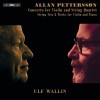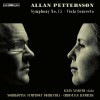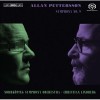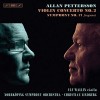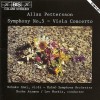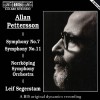Composers
Gustaf (or Gustav) Allan Pettersson (19 September 1911 – 20 June 1980) was a Swedish composer. Today he is considered one of the most important Swedish composers of the 20th century. His symphonies developed a devoted international following, starting in the final decade of his life.
Pettersson, one of four children of a violent, alcoholic blacksmith, was born at the manor of Granhammar in Västra Ryd parish in the province of Uppland, but grew up in poor circumstances in Stockholm, where he resided during his whole life. He once said of himself: "I wasn't born under a piano, I didn't spend my childhood with my father, the composer... no, I learnt how to work white-hot iron with the smith's hammer. My father was a smith who may have said no to God, but not to alcohol. My mother was a pious woman who sang and played with her four children."[1]
In 1930, he began study of violin and viola, as well as counterpoint and harmony, at the Conservatory of the Royal Swedish Academy of Music. He became a distinguished viola player but also started composing songs and smaller chamber works in the 1930s. At the beginning of the second world war he was studying the viola with Maurice Vieux in Paris.[2][3] During the 1940s he worked as a violist in the Stockholm Concert Society Orchestra (later Stockholm Philharmonic Orchestra), but also studied composition privately with Karl-Birger Blomdahl, Tor Mann and Otto Olsson.[3] His production from this decade include the song cycle twenty-four Barefoot Songs (1943–45) based on own poems and a concerto for violin and string quartet (1949).
In 1951 Pettersson composed the first of his seventeen symphonies, which he left unfinished. This work has recently been recorded in a performing version prepared by trombonist and conductor Christian Lindberg.[4] The later symphonies were to follow in rapid succession. Also in 1951 he went to Paris to study composition, having been a student of René Leibowitz, Arthur Honegger and Darius Milhaud.[3][5][6]
Pettersson returned to Sweden in 1953. That same year he was given the diagnosis polyarthritis and, by the time of his fifth symphony, completed in 1962, his mobility and health were considerably compromised.[7][8] It took three years to write the sixth symphony (1963–66). His greatest success came a few years later with his seventh symphony (1966–67), which was premiered on 13 October 1968 in Stockholm Concert Hall with Antal Doráti conducting the Stockholm Philharmonic Orchestra.[9] The release of a recording of his seventh symphony with same conductor and orchestra in 1969 was a breakthrough, establishing his international reputation (Grammis 1970). The seventh and the eighth symphony (1968–69) have received more recordings than his other works. The conductors Antal Doráti and Sergiu Comissiona premiered (and made premiere recordings of) several of Pettersson's symphonies and contributed to his rise to fame during the seventies.
He was hospitalized for nine months in 1970, soon after the composition of his ninth and longest symphony, beginning to write the tenth (1972) from his sickbed.[10] He recovered, but polyarthritis confined him most of the time to his apartment.[11][12] He composed two related works about social protest and compassion, the twelfth symphony for mixed chorus and orchestra (1973–74) to poems by Pablo Neruda with contemporary relevance and the cantata Vox Humana (1974) on texts by Latin American poets. During the last decade of his life he also wrote a concerto for violin and orchestra (1977–78, revised version 1980) written for the violinist Ida Haendel, a sixteenth symphony (1979) which features a bravura solo part for alto saxophone commissioned by Frederick L. Hemke and an incomplete, posthumously discovered concerto for viola and orchestra (1979/80).[13] He also started to write a seventeenth symphony, but he died in Maria Magdalena parish, Stockholm, aged 68, before finishing it.
Pettersson's writing is very strenuous and often has many simultaneous polyphonic lines; earlier works are close to tonality in their melodic approach, later works less so. His symphonies all end on common chords—major or minor chords—but tonality, which depends on some sense, however attenuated, of tonal progression, is found mostly in slower sections: e.g., the openings and endings of his 6th and 7th symphonies, and the end of his 9th. The musical argument seems to be determined, in faster sections, by motivic requirements far more than by harmonic resolution, as exemplified by the study score of the 7th symphony, pp. 20–44. Most of his symphonies are written in a single movement, making them all the more demanding. Overwhelmingly serious in tone, often dissonant, his music rises to ferocious climaxes, relieved, especially in his later works, by lyrical oases.
Pettersson’s music has a very distinctive sound and can hardly be confused with that of any other 20th-century composer. His symphonies, which range in length from 22 to 70 minutes,[15] are typically one-movement works made up of successive stretches of music of varying rhythms and figurations. The effect is like listening to a gigantic toccata or chorale prelude. Sometimes the effect is predominantly that of dance-music, as in the Symphony No. 9, which sounds for long stretches like a huge Mahler scherzo, sometimes the effect is grimmer, with march rhythms or angry declamation predominating, as in the Symphony No. 13.
Pettersson maintains the listener’s interest by varying the sounds and moods of the different sections, so some are more lyrical, others faster and more angry. The architecture of his symphonies is built on similar thematic material emerging at key points in the work (rather than classical statement-development-recapitulation), by rhythmic vitality and tonal progression. Several of his compositions cite songs from his own 24 Barefoot Songs.[16][17] Even though his symphonies are some of the longest single movement orchestral works ever written[citation needed], they are intensely compelling. The effect they convey is of great vitality and unstoppable momentum.
Most of his music has now been recorded at least once and much of it is now available in published score.
Symphonies 7 and 8 are probably his best-known works.
Recently Added
Biography
Gustaf (or Gustav) Allan Pettersson (19 September 1911 – 20 June 1980) was a Swedish composer. Today he is considered one of the most important Swedish composers of the 20th century. His symphonies developed a devoted international following, starting in the final decade of his life.
Pettersson, one of four children of a violent, alcoholic blacksmith, was born at the manor of Granhammar in Västra Ryd parish in the province of Uppland, but grew up in poor circumstances in Stockholm, where he resided during his whole life. He once said of himself: "I wasn't born under a piano, I didn't spend my childhood with my father, the composer... no, I learnt how to work white-hot iron with the smith's hammer. My father was a smith who may have said no to God, but not to alcohol. My mother was a pious woman who sang and played with her four children."[1]
In 1930, he began study of violin and viola, as well as counterpoint and harmony, at the Conservatory of the Royal Swedish Academy of Music. He became a distinguished viola player but also started composing songs and smaller chamber works in the 1930s. At the beginning of the second world war he was studying the viola with Maurice Vieux in Paris.[2][3] During the 1940s he worked as a violist in the Stockholm Concert Society Orchestra (later Stockholm Philharmonic Orchestra), but also studied composition privately with Karl-Birger Blomdahl, Tor Mann and Otto Olsson.[3] His production from this decade include the song cycle twenty-four Barefoot Songs (1943–45) based on own poems and a concerto for violin and string quartet (1949).
In 1951 Pettersson composed the first of his seventeen symphonies, which he left unfinished. This work has recently been recorded in a performing version prepared by trombonist and conductor Christian Lindberg.[4] The later symphonies were to follow in rapid succession. Also in 1951 he went to Paris to study composition, having been a student of René Leibowitz, Arthur Honegger and Darius Milhaud.[3][5][6]
Pettersson returned to Sweden in 1953. That same year he was given the diagnosis polyarthritis and, by the time of his fifth symphony, completed in 1962, his mobility and health were considerably compromised.[7][8] It took three years to write the sixth symphony (1963–66). His greatest success came a few years later with his seventh symphony (1966–67), which was premiered on 13 October 1968 in Stockholm Concert Hall with Antal Doráti conducting the Stockholm Philharmonic Orchestra.[9] The release of a recording of his seventh symphony with same conductor and orchestra in 1969 was a breakthrough, establishing his international reputation (Grammis 1970). The seventh and the eighth symphony (1968–69) have received more recordings than his other works. The conductors Antal Doráti and Sergiu Comissiona premiered (and made premiere recordings of) several of Pettersson's symphonies and contributed to his rise to fame during the seventies.
He was hospitalized for nine months in 1970, soon after the composition of his ninth and longest symphony, beginning to write the tenth (1972) from his sickbed.[10] He recovered, but polyarthritis confined him most of the time to his apartment.[11][12] He composed two related works about social protest and compassion, the twelfth symphony for mixed chorus and orchestra (1973–74) to poems by Pablo Neruda with contemporary relevance and the cantata Vox Humana (1974) on texts by Latin American poets. During the last decade of his life he also wrote a concerto for violin and orchestra (1977–78, revised version 1980) written for the violinist Ida Haendel, a sixteenth symphony (1979) which features a bravura solo part for alto saxophone commissioned by Frederick L. Hemke and an incomplete, posthumously discovered concerto for viola and orchestra (1979/80).[13] He also started to write a seventeenth symphony, but he died in Maria Magdalena parish, Stockholm, aged 68, before finishing it.
Pettersson's writing is very strenuous and often has many simultaneous polyphonic lines; earlier works are close to tonality in their melodic approach, later works less so. His symphonies all end on common chords—major or minor chords—but tonality, which depends on some sense, however attenuated, of tonal progression, is found mostly in slower sections: e.g., the openings and endings of his 6th and 7th symphonies, and the end of his 9th. The musical argument seems to be determined, in faster sections, by motivic requirements far more than by harmonic resolution, as exemplified by the study score of the 7th symphony, pp. 20–44. Most of his symphonies are written in a single movement, making them all the more demanding. Overwhelmingly serious in tone, often dissonant, his music rises to ferocious climaxes, relieved, especially in his later works, by lyrical oases.
Pettersson’s music has a very distinctive sound and can hardly be confused with that of any other 20th-century composer. His symphonies, which range in length from 22 to 70 minutes,[15] are typically one-movement works made up of successive stretches of music of varying rhythms and figurations. The effect is like listening to a gigantic toccata or chorale prelude. Sometimes the effect is predominantly that of dance-music, as in the Symphony No. 9, which sounds for long stretches like a huge Mahler scherzo, sometimes the effect is grimmer, with march rhythms or angry declamation predominating, as in the Symphony No. 13.
Pettersson maintains the listener’s interest by varying the sounds and moods of the different sections, so some are more lyrical, others faster and more angry. The architecture of his symphonies is built on similar thematic material emerging at key points in the work (rather than classical statement-development-recapitulation), by rhythmic vitality and tonal progression. Several of his compositions cite songs from his own 24 Barefoot Songs.[16][17] Even though his symphonies are some of the longest single movement orchestral works ever written[citation needed], they are intensely compelling. The effect they convey is of great vitality and unstoppable momentum.
Most of his music has now been recorded at least once and much of it is now available in published score.
Symphonies 7 and 8 are probably his best-known works.

